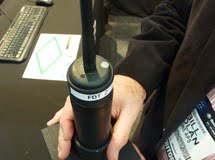PERIMETER detection solutions with real ‘resolution’ have a single defining feature – high cost. If you have a large perimeter getting electronic security capable of pin-pointing the location of intruders is going to be a challenge.
The trenching and support infrastructure for technology like leaky coax is comparatively expensive, while microwave can also be costly and requires a stable detection environment and plenty of room for signal spillage.
IR stacks are useful in smaller applications but they are frail when hit with direct sunlight and can be hamstrung by bad weather, especially rain and fog. It goes without saying that IR and microwave struggle in rugged country where video-based movement detection solutions (not thermal cameras) which by default demand line of sight, also fail completely.
It’s here that GRIDS, for Ground Radar Intrusion Detection System, comes in. This solution penetrates dense foliage and can support perimeters of many kilometres making as useful for rugged applications as it is for well-planned sterile areas. GRIDS technology is exceedingly flexible. Multiple systems can be implemented to form a sensor barrier of any length, from a few metres to hundreds of kilometres.
In terms of hardware, this solution comprises a network of low power integrated sensing and comms devices which are installed in an array with an adjacent Gateway that gathers data from the sensors wirelessly and sends it on to a control room or guard house.
The first thing I notice about GRIDS is its simplicity. The devices that make up the array are tubular units with an antenna protruding from their top – a little like an electronic carrot. Installers simply bury these wee devices around the perimeter of a site. Thanks to the low current draw an onboard battery powers a GRIDS sensor for 5 years – that means you can forget about expensive power infrastructure installation.
The GRIDS sensor network can detect vehicles and walking personnel in all weather conditions. It’s relatively insensitive to small animals (such as wallabies and rabbits) and this minimizes nuisance alarms. There’s automatic adjustment to changing environmental conditions (such as wind, rain, and foliage growth) prevents false alarms and the operating frequency of the system’s radar technology is impervious to environmental conditions.
Something else that’s neat is that GRIDS self-calibrates and there’s a management system built around True Basic Silver Edition. Overall system operation relies on an unmanned communication network. The way a system functions is the GRIDS system sensors communicate to the unmanned Gateway located near the array, which relays data to a manned location.
Redundant communication links with other devices in an array ensure continuous operation in cases of tampering and/or unit failure. In addition, built-in test features provide system health information and the ability to reprogram system parameters for optimal operation.
Importantly, GRIDS can easily be networked into overall larger security system of radars and optical sensors using a single control point for gathering and disseminating intrusion detection data for interdiction forces. Only the last sensor in the array must have access to the Gateway, leaving an unprecedented flexibility of placement for all other sensors in the array. Borders, boundaries and perimeters can have exceedingly diverse layouts allowing them to follow topography or site boundaries in a linear fashion.
According to Zone’s Bill Nolan GRIDS sensors are deployed in a ‘W’ pattern.
“The units talk to each other constantly and if one goes down this is reported along the line to the Gateway so security operators are informed,” he explains.
“The GRIDS units are GPS stamped before they are buried so we know where they are. Installation takes place in a 20m wide strip and if you get an intrusion you will get multiple hits from sensors in the ‘W’ layout. With traditional perimeter systems when the system detects an event you often don’t know which way they have come but this system gives a rudimentary sense of from which direction the threat may be coming.
“There’s no infrastructure required – you dig a hole and put the device in and the antenna sticks out – it’s static radar technology – it picks up a deviation in the electrostatic field caused by the mass that’s going through it and the system can tell the difference between a human and an animal. It’s a complex technology – the inventor it is called Walter Butler – he used to be the inventor of all the STS radar systems.
“There’s no trenching and no backhoes, and there’s an installation kit that digs, installs and backfills each node installation – it’s very, very simple and a very capable solution,” Nolan says.
“Another great thing is that GRIDS is made locally so you know there’s a manufacturer who’s serious about it and it’s supported locally by us at Zone.”
17.3
C
Sydney
11.5
C
Canberra
29.5
C
Darwin
8.9
C
Hobart
24.2
C
Perth
19.4
C
Brisbane
14
C
Auckland
21
C
Melbourne
- Advertisement -








